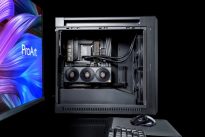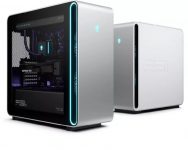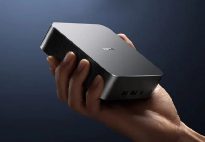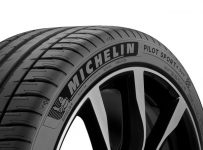Hot heads: how to cool your computer during summer heat
23.07.12
The coming summer, according to weather forecasters, promises to be quite hot. And you readily believe this, remembering the unprecedented heat already in mid-April. This means that our computers, or rather their components, will again be subject to additional load in the form of extra degrees. Of course, if you have air conditioning at home, then you don’t have to worry about this, but if you don’t, there is a real threat of components overheating and failing. How to help our electronic friends in the summer heat? Simple, inexpensive and advanced methods will be discussed further.
Advanced cooling
There are many ways to further cool your PC. For example, using radiator, liquid, freon, liquid nitrogen and liquid helium cooling, as well as cooling based on liquid metal. Such systems are used mainly in overclocking, and ordinary users do not have an urgent need for them. Actually, it’s like comparing the needs of a racing driver and an ordinary (even advanced) car enthusiast. The difference between these very technical needs is obvious.
Water cooling systems are deservedly popular among overclockers. The principle of their operation is based on coolant circulation. Computer components that need cooling heat the water, and the water, in turn, is cooled in the radiator. In this case, the radiator can be located outside the case and even be passive (that is, work without a heat sink fan)..
Special mention should be made about cryogenic cooling systems for PCs, which work on the principle of changing the phase state of matter, like a refrigerator and air conditioner. The disadvantages of cryogenic systems are high noise, large mass and cost, and difficulty in installation. But only using such systems is it possible to achieve negative temperatures of the processor or video card, and, accordingly, the highest performancethrough strong overclocking.
It is worth adding a few words about the advantages of complex cooling systems. They are silent, and at any time you can enable forced enhanced cooling in your PC. Among the disadvantages for the average user, it is worth noting the rather high cost (from $100) finished system, the requirement for great care when using it and the need for additional accessories during installation. In any case, experiments with these types of cooling should be carried out only when necessary – if your PC has truly enormous power.
Air is our everything!
But, if you do not have a top-end gaming system and you are not an avid overclocker, then you probably won’t need a water system, much less a liquid nitrogen one, or any other sophisticated system. In order to lower the temperature by a few degrees (up to ten), which is what is required in the hottest summers, it will be enough to update the conventional air cooling (and also do a couple of simple steps; see the “10 Commandments of Proper Cooling” box). To do this, it will be enough to add several new coolers or update existing ones. In this context, it is important to remember that for proper, productive air cooling, location plays an important role.
The coming summer, according to weather forecasters, promises to be quite hot. And you readily believe this, remembering the unprecedented heat already in mid-April. This means that our computers, or rather their components, will again be subject to additional load in the form of extra degrees. Of course, if you have air conditioning at home, then you don’t have to worry about this, but if you don’t, there is a real threat of components overheating and failing. How to help our electronic friends in the summer heat? Simple, inexpensive and advanced methods will be discussed further.
Advanced cooling
There are many ways to further cool your PC. For example, using radiator, liquid, freon, liquid nitrogen and liquid helium cooling, as well as cooling based on liquid metal. Such systems are used mainly in overclocking, and ordinary users do not have an urgent need for them. Actually, it’s like comparing the needs of a racing driver and an ordinary (even advanced) car enthusiast. The difference between these very technical needs is obvious.
Water cooling systems are deservedly popular among overclockers. The principle of their operation is based on coolant circulation. Computer components that need cooling heat the water, and the water, in turn, is cooled in the radiator. In this case, the radiator can be located outside the case and even be passive (that is, work without a heat sink fan)..
Special mention should be made about cryogenic cooling systems for PCs, which work on the principle of changing the phase state of matter, like a refrigerator and air conditioner. The disadvantages of cryogenic systems are high noise, large mass and cost, and difficulty in installation. But only using such systems is it possible to achieve negative temperatures of the processor or video card, and, accordingly, the highest performancethrough strong overclocking.
Cold and silent: This is how a PC equipped with a water cooling system looks quite nice. The great advantage of such a system is that the computer operates almost silently.
It is worth adding a few words about the advantages of complex cooling systems. They are silent, and at any time you can enable forced enhanced cooling in your PC. Among the disadvantages for the average user, it is worth noting the rather high cost (from $100) finished system, the requirement for great care when using it and the need for additional accessories during installation. In any case, experiments with these types of cooling should be carried out only when necessary – if your PC has truly enormous power.
Air is our everything!
But, if you do not have a top-end gaming system and you are not an avid overclocker, then you probably won’t need a water system, much less a liquid nitrogen one, or any other sophisticated system. In order to lower the temperature by a few degrees (up to ten), which is what is required in the hottest summers, it will be enough to update the conventional air cooling (and also do a couple of simple steps; see the “10 Commandments of Proper Cooling” box). To do this, it will be enough to add several new coolers or update existing ones. In this context, it is important to remember that for proper, efficient air cooling, the location of the fans plays an important role. In fact, the maximum effect is achieved not when as much cold air as possible is pumped into the case, but when effective air flows are organized, with the correct input of cold air inside and the removal of warm air outside (if all the fans work for blowing, the air inside will simply heat up quickly , not being able to leave the normal outside the body).
The possibilities of installing additional fans depend not only on your wallet, but also on the case. In this regard, you won’t envy the owners of the old or cheapest cases. Often they do not have additional places for installing coolers, and the hot air extraction in them is very simple: the flows are removed using a fan located on the power supply and the back wall of the computer. This creates a serious load not only on it, but also on the processor, which in most motherboards is installed right at the top. Therefore, if you are buying a new computer, do not regret the extra 300-400 UAH for the case. And the old PC can be moved to a new “home” – it’s not difficult to do.
Most modern cases provide several places for installing coolers. If you carefully read the case tests in several previous issues of our magazine, you probably noticed that in the technical specifications we indicated the number of not only pre-installed coolers, but also seats for additional ones. Let’s look at where it is best to install which fans (for simplicity, we will assume that our virtual case has seats on all panels).
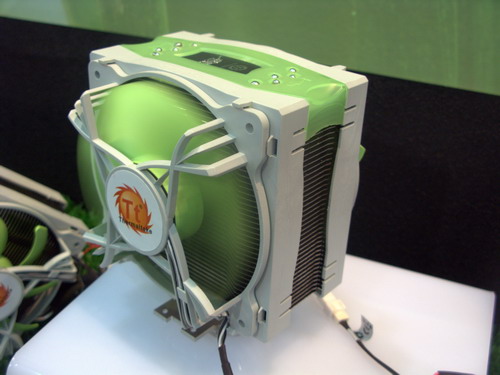
Advanced cooler models have a number of advantages over conventional fans. For example, this cute green “baby” from ThermalTake, thanks to its six copper heatpipes, has a heatsink located quite far from the processor. To cool the radiator, two fans are used at once. One pumps air, the other effectively removes it
For injection:
Coolers operating on blowing must be installed on the front panel. There they will effectively cool the hard drives and force air inside – a kind of gate for cold air. If you have one hard drive, you can get by with such blower fans, but it is better (and if there are several hard drives, then it is highly recommended) to install the fans on the side panels (or on one of them, often there are such places on the left, less often on both , well, a completely exceptional case, when only on the right). As a result, air will be pumped directly into the area of the motherboard (that is, directly onto the processor and video card, which will be a significant help for their standard cooling systems) and refresh the air flow from the front panel, heated by the hard drives. If there is such an opportunity, you can put a fan on the bottom panel (bottom) – cold air from the bottom will also effectively complement the air flows and better displace heated air to the top.
For blowing:
Coolers that remove warm air outside the case are placed on the back and, if possible, on the top panel. Thus, we get a constant blowing air flow, which effectively cools all PC components and instantly, when heated, goes outside the case, thus freeing up space for cold air.
What not to do:
Set the fan on the rear panel to blow. Because of this, a closed air ring is created between the power supply and the cooler, and some of the hot air from the power supply is immediately sucked back inside.
Set the front fan to blow out. There are several options here, depending on the location of other fans, but in any case, given that the cooler on the power supply also works as a blower, effective air flow will not work, and the hard drives will carry an additional thermal load.
Perhaps the most clinical case is when all the fans are blowing, thus creating a rarefied atmosphere and low pressure inside the case. Yes, we know that a rarefied environment heats up worse, but with such a design of the cooling system there will be almost no air movement inside, and the air that exists will still heat up significantly over time. This scheme, by the way, is the heaviest for PC components, which have nowhere to throw off the accumulated heat.

The cooling method indicated in the diagram is one of the most effective. Depending on needs, blow-in coolers can be delivered to the bottom and side panels
Silence is the key to health
Some users are deterred from installing additional fans by the fact that this will increase the noise level emitted by the system. But in reality, the number of additional decibels can be kept to a minimum. Here are some recommendations:
1. If the slot allows, buy a larger fan. Contrary to popular belief, with the same volume of air blown in, it will make less noise than a small one, due to the fact that it needs to make fewer revolutions to do this. A larger number of blades will also contribute to less noise generation.
2. Some cases have a function for manually adjusting the fan speed. If yours does not have one, you can use special programs (they have the ability to automatically adjust depending on the temperature of the components). In any case, maximum cooler speeds are not always needed, and at minimum speeds the system, even with many coolers, will work very quietly.
3. If the motherboard has four-pin connectors for powering coolers, then buy four-wire fans. They are very quiet, and their automatic speed control range is quite wide.
4. Pay attention to the type of bearing. For example, hydrodynamic bearings ensure very quiet fan operation.

The Zalman ZM-F2 FDB cooler uses a hydrodynamic bearing, which significantly reduces vibration and, as a result, noise level.
Younger “brothers”
When it comes to cooling laptops, the story is completely different and much more complicated. Althoughin terms of heat dissipation they are much inferior to desktop PCs, and the optimal design of heat sinks in them is laid out by the manufacturer himself, changing anything in the laptop’s cooling system (if its capabilities are insufficient) is very problematic. So to speak, there is nowhere to screw in an additional cooler. Therefore, there are other options. By the way, the first thing worth mentioning is the same notorious installation of a program for checking temperatures. You can find out the normal temperature for specific laptop components on the manufacturer’s website. Although there are still approximate standards for laptops. So, for a processor, the normal temperature can be considered 75–80 °C under load (if above 90, it is definitely overheating); for video card — 70–90 °C; for hard drive — 50–55 (if above 60, then you should copy important data from the hard drive. There is a risk of losing it); and the chipset can easily withstand temperatures up to 90 °C.
The golden rule of a laptop user should be to check that the ventilation holes are not blocked. Under no circumstances should the computer be placed on a bed or other upholstered furniture, blankets, etc., as the characters in many movies do. That’s why they are films, and the laptop is guaranteed to overheat. Usually nothing bad happens, but in some cases the video card, north and south bridges may fail. The hard drive may also fail, leading to loss of information. This happens because chips have a maximum temperature, after which their structure begins to deteriorate. Usually this is 110–125 °C. At this temperature, both the chip itself and the contact between the chip and the board are damaged. As a result, the laptop may either not turn on at all due to problems with the chipset, or display various artifacts on the screen. But the processor fails very rarely.
If you really want to work on a bed, but you can’t spend money on a cooler–stand, you can use a regular plastic/metal/wooden one to work in a chair or bed a food tray or plywood board according to the size of the device. Naturally, you should make sure that no ventilation openings are blocked.
When using a laptop at a table, there is one trick – put something under its back end. In most cases, the air that cools the laptop components is drawn through holes and slots in the bottom of the laptop. Some air is also sucked in from the keyboard. When you lift the back end of the laptop, the gap between the bottom and the table increases. As a result, air circulation improves. In other words, the air that is forced through the radiator of the cooling system becomes colder. Also, by reducing the resistance of this air, more air is sucked in. As a result, the temperature may drop by 5–10 °C. You can put anything under the back end, from books to rubber bands. Although there are special gadgets for this, for example, Belkin Laptop CoolStrip.
Finally, laptop coolers are also a good option for cooling. But again, not everyone is effective enough. For example, small folding fans that are placed under a laptop usually simply disperse the air around them and raise dust. It is optimal to take a stand that is not curved inward, but with a straight surface, perhaps slightly tilted for greater convenience, so that the laptop screen is positioned a little higher. The majority of such models are CoolerMaster NotePal, Zalman, Vantec LapCool and many others. By the way, with additional cooling, the maximum heating of the laptop is 4–5 °C less than without it. And cooling to a normal level occurs much faster: returning to the “background” temperature value takes only about two minutes, and without it – almost 15.
10 commandments of proper cooling
Like the mathematician and philosopher Rene Descartes, let’s go from simple to complex. Repeating common truths about PC cooling sometimes helps to understand what was missed. So…
1. It is better to lower the system unit lower (ideally, on a special stand on wheels). From your school physics course, everyone probably remembers that hot air usually rises, and cold air goes down.
2. Examine the environment of the system unit to see if there are any curtains, napkins, chairs or other household utensils nearby that may interfere with the proper air exchange of the computer.
3. Regularly clean the inside of your PC with a vacuum cleaner. Dust and animal hair can very noticeably clog coolers, especially on the power supply.
4. Set the coolers on the front panel to blow in, and on the back to blow out.
5. Make sure that in this case there are no large gaps in the system unit (for example, holes from the removed socket for the drive).
6. The wires inside should also not interfere with air circulation, so they should be carefully laid and secured with ordinary clamps.
7. Check the availability of thermal paste and, if necessary, renew it (a 50-gram tube costs a penny, but it will last for 40-50 cleanings) . To do this, you need to remove the coolers from the processor and video card and carefully wipe off the remnants of old thermal paste with alcohol, then just as carefully lubricate the contact surfaces of the processor and radiator and put everything back in place.
8. If there are several hard drives in the case, they should be placed in slots away from each other.
9. If possible, do not connect power-consuming devices such as USB refrigerators, fans, etc. to your PC (especially laptops).
10. If necessary, replace the standard coolers with more advanced ones or deliver new ones if there are corresponding slots on the case.
The above-mentioned techniques for PCs – cleaning dust and updating thermal paste – are also good for laptops. Although, of course, you should disassemble them yourself only under the following conditions: a) the warranty period has expired and the seals can be broken; b) you are sure that you will put the laptop back together (with a PC, in terms of assembly, everything is much simpler). If the first condition is not met, but you suspect that your portable “friend” is clogged, it is better to contact a service center. Replacing thermal paste requires experience and knowledge, and the warranty is lost if you clean it yourself.

Laying wires inside a PC takes five minutes, but the effectiveness will be obvious
Editor
Don't miss interesting news
Subscribe to our channels and read announcements of high-tech news, tes
Oppo A6 Pro smartphone review: ambitious

Creating new mid-range smartphones is no easy task. Manufacturers have to balance performance, camera capabilities, displays, and the overall cost impact of each component. How the new Oppo A6 Pro balances these factors is discussed in our review.
Editor’s Choice 2025. Best devices of the year by hi-tech.ua

The best gaming laptops, mice for work, gaming keyboards, smartphones, and wireless headphones of 2025. Among them, we will highlight the most interesting ones and those that we can recommend buying.
Michelin has created a real-time tire monitoring system car CES development
Michelin is preparing to introduce a new line of “smart” tires capable of real-time
BYD showed ultra-fast charging for electric cars: 400 km in 5 minutes charger development electric transport
BYD is one step closer to its goal of making electric vehicle charging comparable in speed to refueling vehicles with an internal combustion engine

